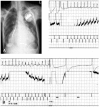Implantable cardioverter-defibrillator implantation in a patient with atrial standstill
- PMID: 19259364
- PMCID: PMC2649870
- DOI: 10.3349/ymj.2009.50.1.156
Implantable cardioverter-defibrillator implantation in a patient with atrial standstill
Abstract
We report a 55-year-old female patient who presented with no P waves but with a wide QRS complex escape rhythm at 44 beats/min and prolonged QTc of 0.55 seconds on ECG. The patient had recurrence of ventricular fibrillations and loss of consciousness, and underwent defibrillation and cardiopulmonary resuscitation (CPR) several times because of cardiac arrest. The transthoracic echocardiography showed dilated cardiomyopathy and enlargement of both atria. The Doppler echocardiography documented the absence of A wave in the tricuspid and mitral valve flow. An electrophysiologic study demonstrated electrical inactivity in the right and left atria. Atrial pacing with maximum output did not capture the atria. These findings together with her electrocardiographic finding indicated atrial standstill. Sudden cardiac death was her first clinical manifestation of ventricular arrhythmia. The patient remained asymptomatic after receiving a single chamber implantable cardioverter-defibrillator (ICD) with VVI pacemaker function.
Keywords: Atrial standstill; cardiopulmonary resuscitation; dilated cardiomyopathy; sudden cardiac death.
Figures


Similar articles
-
Partial atrial standstill: a case report.J Electrocardiol. 2005 Jul;38(3):252-5. doi: 10.1016/j.jelectrocard.2005.01.009. J Electrocardiol. 2005. PMID: 16003711
-
Factors predisposing to ventricular tachyarrhythmia leading to appropriate ICD intervention in patients with coronary artery disease or non-ischaemic dilated cardiomyopathy.Kardiol Pol. 2012;70(12):1264-75. Kardiol Pol. 2012. PMID: 23264245
-
[Factors predisposing to the reprogramming of implantable cardioverter-defibrillators and the causes of changes in pharmacotherapy in patients with dilated cardiomyopathy for primary prevention of sudden cardiac death].Pol Merkur Lekarski. 2015 Aug;39(230):86-90. Pol Merkur Lekarski. 2015. PMID: 26319381 Polish.
-
[Risk stratification for sudden cardiac death in post-infarct patients and in patients with dilated cardiomyopathy].Z Kardiol. 2000;89 Suppl 10:11-9; discussion 19-20. doi: 10.1007/s003920070003. Z Kardiol. 2000. PMID: 11151769 Review. German.
-
Risks and challenges of implantable cardioverter-defibrillators in young adults.Prog Cardiovasc Dis. 2008 Nov-Dec;51(3):237-63. doi: 10.1016/j.pcad.2008.10.001. Prog Cardiovasc Dis. 2008. PMID: 19026858 Review.
Cited by
-
Atrial standstill in a patient with progressive severe heart failure.Clin Res Cardiol. 2013 Jun;102(6):473-6. doi: 10.1007/s00392-013-0557-2. Epub 2013 Mar 26. Clin Res Cardiol. 2013. PMID: 23529655 No abstract available.
-
Fever-induced QTc prolongation and ventricular fibrillation in a healthy young man.Yonsei Med J. 2011 Nov;52(6):1025-7. doi: 10.3349/ymj.2011.52.6.1025. Yonsei Med J. 2011. PMID: 22028170 Free PMC article.
References
-
- Fazelifar AF, Arya A, Haghjoo M, Sadr-Ameli MA. Familial atrial standstill in association with dilated cardiomyopathy. Pacing Clin Electrophysiol. 2005;28:1005–1008. - PubMed
-
- Bensaid J. Persistent atrial standstill documented over a 22-year period. Am Heart J. 1996;131:404–407. - PubMed
-
- Marini M, Arbustini E, Disertori M. Atrial standstill: a paralysis of cardiological relevance. Ital Heart J Suppl. 2004;5:681–686. - PubMed
-
- Bloomfield DA, Sinclair-Smith BC. Persistent atrial standstill. Am J Med. 1965;39:335–340. - PubMed
-
- Rosenbaum FF, Levine SA. Auricular standstill. Its occurrence and significance. Am J Med Sci. 1939;198:774.
Publication types
MeSH terms
LinkOut - more resources
Full Text Sources
Medical

